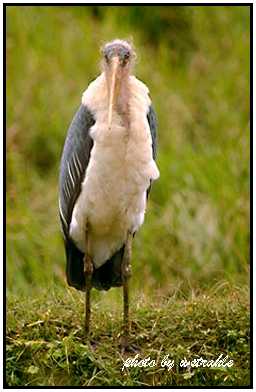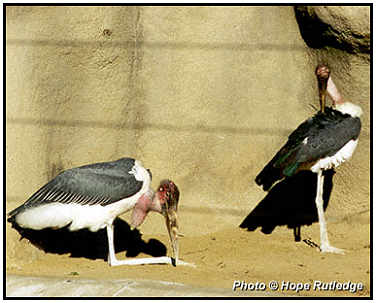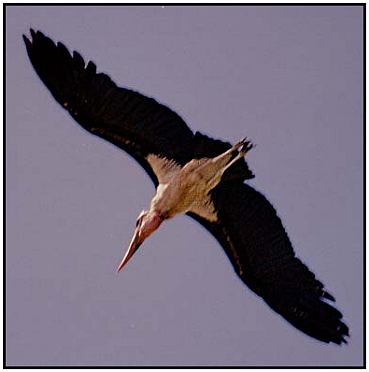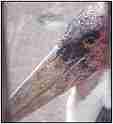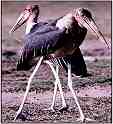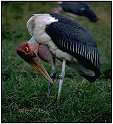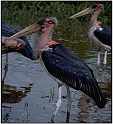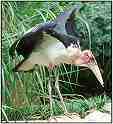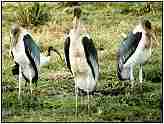Marabou StorkOrder: Ciconiiformes. Family: Ciconiidae. Scientific Name: Leptoptilos crumeniferus. (Translation: 'Slender wing with throat pouch'). Common Names: Marabou Stork or 'Undertaker Bird'. Conservation Status: Common. Though these birds are uncommon over most of their range, they are prolific enough to be considered a pest in some areas, as they congregate near villages to raid rubbish dumps. Rescue & Recovery: None. Geographical Range: Africa. Habitat: Savannahs, plains and marshes.
Marabou Stork (Photograph Courtesy of Bill Strahle Copyright ©2000)Physical Characteristics: The Marabou Stork is a huge 1.5 metre tall bird with a 2.6 metre wing span. In fact, it is so large and heavy that its leg and toe bones are hollow to reduce weight during flight. It has a long, dangling throat sac which is not associated with the ingestion of food; instead it is air-filled and probably used for courtship or breathing. The naked 18-inch inflatable pink sac is particularly conspicuous during the breeding season. It connects directly to the left nostril and acts as a resonator allowing the bird to produce a guttural croaking. While usually silent, the Marabou Stork will also emit a sound caused by beak clacking if it feels threatened. The pink head and neck is naked of feathers, with the rest of the plumage being black and white, and commencing with a white ruff at the base of the neck. Males and females are very alike with the female being slightly smaller.
Marabou Storks (Photograph Courtesy of Hope Rutledge Copyright ©2000)Like the Turkey Vulture, the Marabou Stork defecates upon its legs and feet. It is known that the Turkey Vulture has strong antiseptic properties in their whitewash and indeed this is also the case with the Marabou stork, however their reasons for carrying out this act are different. Quite simply, it helps assist in regulating body temperature -- and also gives the false appearance that the birds have lovely white legs. Like many birds the Marabou Stork also pants when it becomes hot, again to lower its body temperature. These are particularly lazy birds and spend much of their time standing motionless, though once they take flight they are very elegant, using thermal up-draughts to provide the needed lift. Not a good short-distance flyer. Like other storks they fly with their especially long legs trailing behind, but unlike their cousins they keep their neck tucked well in and bent into a flattened S; this allows the weight of the heavy beak to be taken on the shoulders. Life span in the wild is unknown, however zoo birds have lived as long as 20 years. Immature birds have a woolly covering on their heads and do not gain the black in their plumage until about three-years-old. By four-years the full plumage will have grown in.
Marabou Stork in Flight (Photograph Courtesy of Ross Warner Photography Copyright ©2000)Food: A voracious appetite means this bird will eat almost anything from carrion, to termites, snakes, adult flamingo and baby crocodiles. In the case of flamingo, or flamingo chicks, there is little adults can do to protect their nest against the large, powerful bill of a Marabou Stork. In a large flock of flamingo neighbours will not offer assistance and parents can really only watch helplessly while their chicks are slaughtered and eaten. This is the only species of stork to eat carrion and will often gather with vultures at a carcass, where it rules the roost, with even the largest vultures giving way to the bad-tempered Marabou Stork. They thrust their heads deep inside carcasses and are very aggressive when feeding. In Uganda their diet consists almost exclusively of carrion. Can frequently be found feeding from rubbish dumps near villages. They also gather near grass fires where they can easily catch animals fleeing from the flames. Reproduction: During the dry season Marabou Storks nest in large trees, often in villages and towns. (There is one known exception to this, a colony in Zambia which is cliff-dwelling). They lay from three to five eggs and the incubation period varies greatly from 30 to 50 days, with both parents involved. Young birds remain with their parents for up to four months after taking flight. When breeding Marabou Storks become more predatory as they need to catch small prey containing bones to provide their young with adequate calcium for growth. Thumbnails (Click For Full-Size Image):
|

